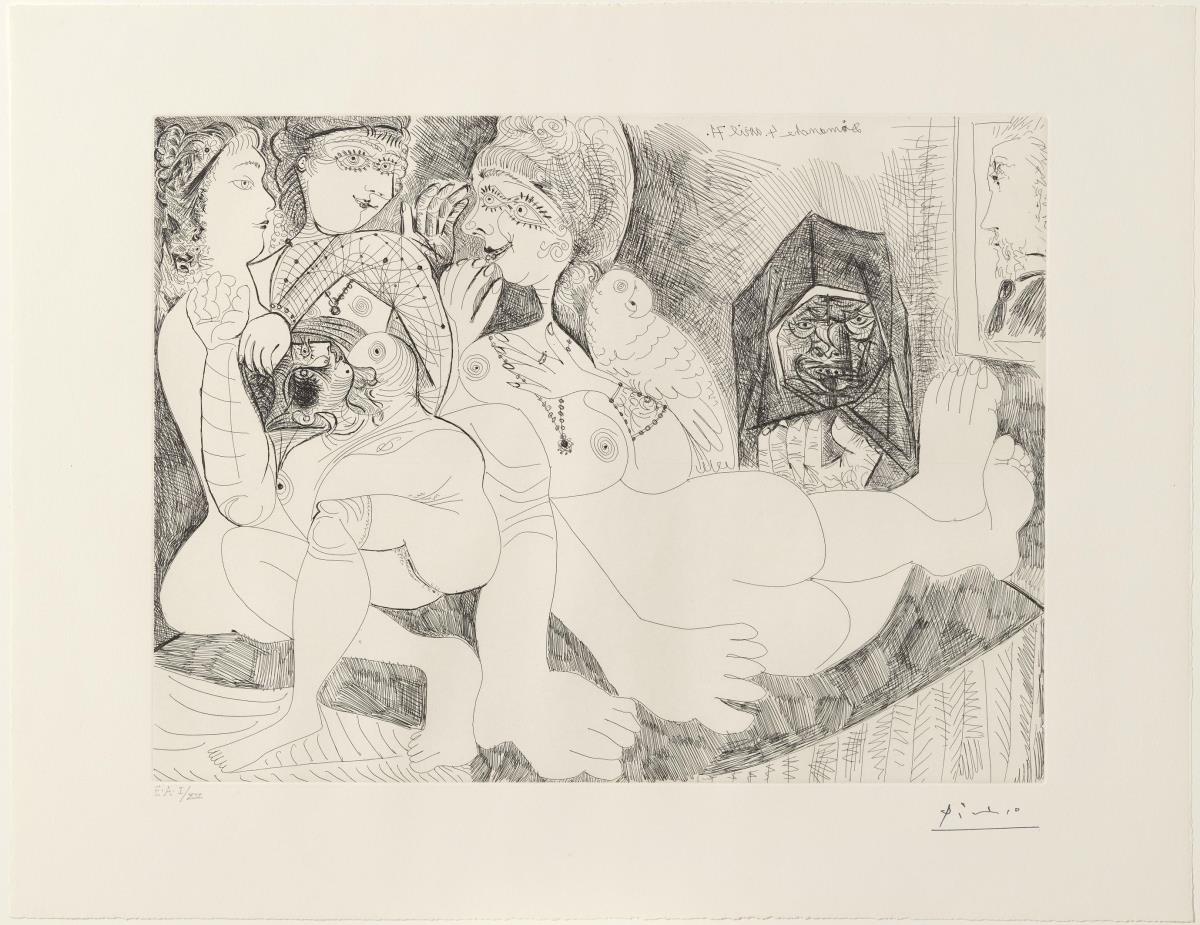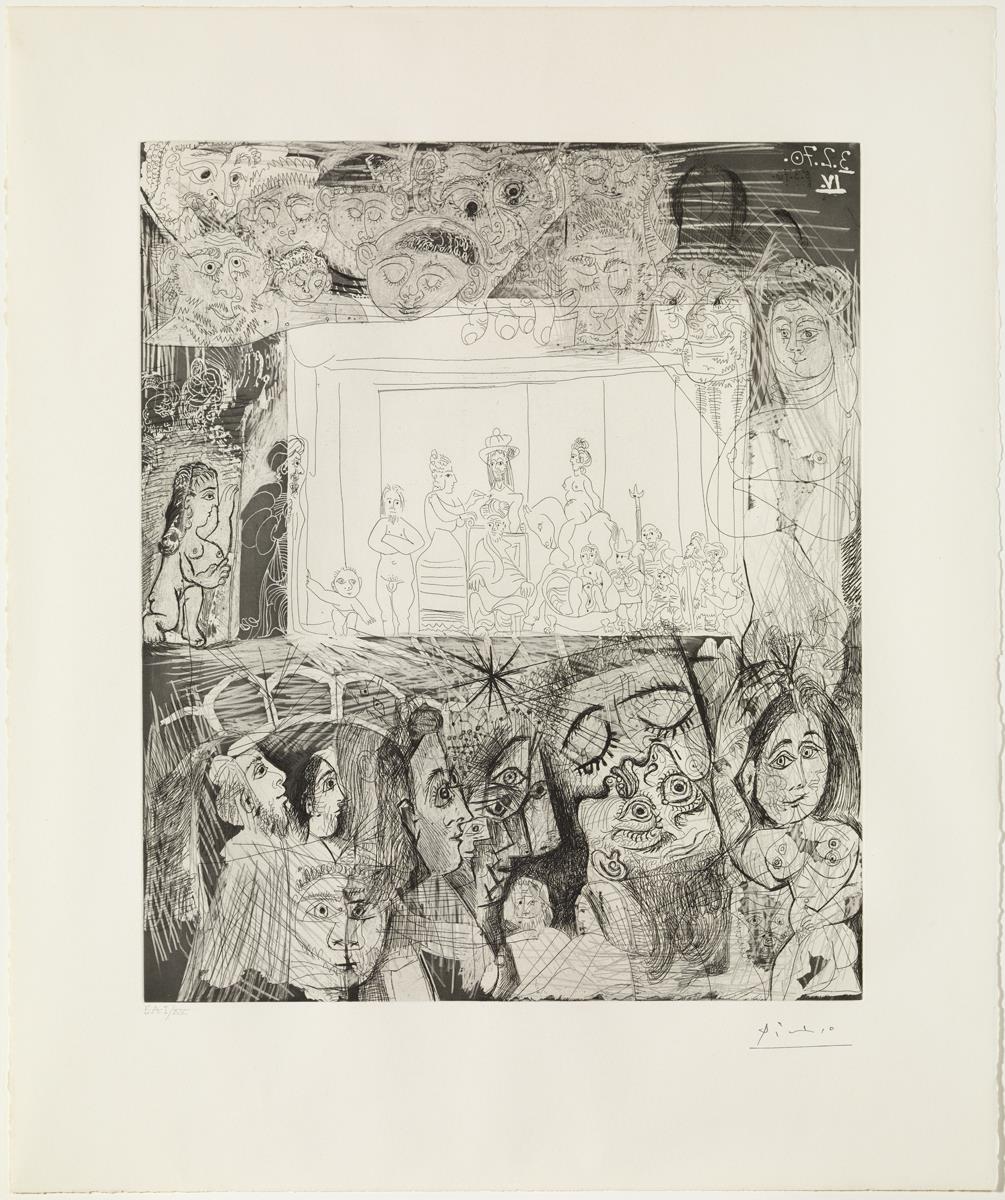Claustre Rafart, curator of the exhibition in the Museu Picasso that exhibits them completely for the first time since 1980, tells us: “The 156 engravings are the film of the life of Picasso”.
This series of engravings, that the artist carried out between 1968 and 1968, are a paradigmatic example of the latter work of Picasso and of his experimentations and trials in various engraving techniques. Thematically, this series of works could be summed up as a final major tragicomedy, in which literary, artistic and autobiographical quotes are mixed together, with a sensuality provided by nude and exhibitionist women, confronted by passive and absent males: the voyeur represented above all by Degas in front of veritable odalisques resulting from the admiration of Picasso by Ingres.
Pablo Picasso. Scene of seduction between a debaucher and a prostitute, with Degas as a voyeur. Plate 95. Mougins, 25 March 1971 (IV). Etching on copper plate, printed on Rives vellum paper (numbered artist's proof). 36.3 x 45.1 cm (paper); 22.7 x 30.5 cm (plate). Museu Picasso, Barcelona. Gift of the Estate of Pablo Picasso, 1979. MPB 112.274. Museu Picasso, Barcelona. Photograph, Gasull Fotografia
Pablo Picasso. Brothel. Gossip, with a parrot, bawd, and the portrait of Degas. Suite 156, plate 109. Mougins, 4 April 1971. Etching on copper plate, printed on Rives vellum paper (numbered artist's proof). 50 x 65.1 cm (paper); 36.4 x 49 cm (paper). Museu Picasso, Barcelona. Gift of the Estate of Pablo Picasso, 1979. MPB 112.184. Museu Picasso, Barcelona. Photograph, Gasull Fotografia
The passions and concerns of the artist are explored in depth in the various sub-topics of the series, such as the work of reflection and appropriation on the engravings of other grand masters, in particular Rembrandt, with the appearance of personages from his works such as the captain Frans Banning Cocq or based around the topic of the Ecce Homo, in which Picasso turns the protagonists of this tragic scene into the characters of his own particular carnival, while maintaining the architectural references; the classic theme of the painter and the model, so present in his work and particularly in the latter Picasso, in this case an often grotesque, decrepit painter; also the gaze of the characters, which questions and involves the spectator highlighting even more the voyeurism of the many masculine characters; the father, who once again appears in some of the autobiographical references, as well as self-portraits as an old person, scraggy and pathetic.
Pablo Picasso. Ecce Homo, after Rembrandt. Mougins, 3 February 1970 (IV), 5 and 6 March 1970. Aquatint, etching, scraping and drypoint on copper plate, printed on Rives vellum paper (numbered artist's proof, V and final state). 68.1 x 56.5 cm (paper); 49.5 x 41.2 cm (plate). Museu Picasso, Barcelona. Gift of the Estate of Pablo Picasso, 1979. MPB 112.172. Museu Picasso, Barcelona. Photograph, Gasull Fotografia
Pablo Picasso. Painter-jester painting on his model, who is making up her eyes. Suite 156, plate 58. Mougins, 25 February 1971. Etching on copper plate, printed on Rives vellum paper (numbered artist's proof). 32.7 x 25.2 cm (paper); 20.6 x 15 cm (plate). Museu Picasso, Barcelona. Gift of the Estate of Pablo Picasso, 1979. MPB 112.308. Museu Picasso, Barcelona. Photograph, Gasull Fotografia
Pablo Picasso. Split self-portrait, maja and dove, removals man with woman and sculpture, ageing fairground Hercules, the artist's father, and Ingresque bather bather in the background. Suite 156, plate 5. Mougins, 25 January, 15 February 1970. Etching, scraping and drypoint on copper plate, printed on Rives vellum paper (numbered artist's proof). 38 x 48.7 cm (paper); 23 x 32.6 cm (plate). Museu Picasso, Barcelona. Gift of the Estate of Pablo Picasso, 1979. MPB 112.287. Museu Picasso, Barcelona. Photograph, Gasull Fotografia
As well as self-portraits, the artist also incorporates artistic self-references, in which he doesn't only reflect on the artists that influenced him but also about his own work, with allusions to Les Demoiselles d'Avignon, the Suite Vollard and, in one of the most divergent engravings of the whole series, the Plate 60, about his works from the 1920s: and in the middle of all this world of powerful women in all their sensuality, another return to a topic that was very present in the young Picasso and in the cultural bohemia that he lived, that of the brothel, in which there are no lack of literary references to La Celestina or to La Maison Tellier, two well-known classics and often referred to by the artist.
Pablo Picasso. Bather-face. Plate 60. Mougins, 27 (II) and 28 February 1971. Etching, scraping and drypoint on copper plate, printed on Rives vellum paper (numbered artist's proof, II and final state). 32.6 x 25.2 cm (paper); 20.6 x 14.9 cm (plate). Museu Picasso, Barcelona. Gift of the Estate of Pablo Picasso, 1979. MPB 112.295. Museu Picasso, Barcelona. Photograph, Gasull Fotografia
Pablo Picasso. Maison Tellier. The manageress's party. Owl. Degas leaning on the wall. Mougins, 14th and 16th June, 1971. Sugar lift aquatint, mordant applied with a brush, drypoint and scraping on copper, printed on Rives vellum paper (numbered artis's proof). 22.9 x 30,6 cm (plate); 36.3 x 45.3 cm (paper). Museu Picasso, Barcelona. Gift of Picasso's Family, 1979
MPB 112.269. Museu Picasso, Barcelona. Photograph, Gasull Fotografia
A unique opportunity to take an in-depth look at this Picassian universe, complex, rich and passionate, in which the artist reflects on love, life and art, with a curiosity and frenetic inventiveness that he would conserve until the end of his life.
Written by the museum’s editor
Related Links












